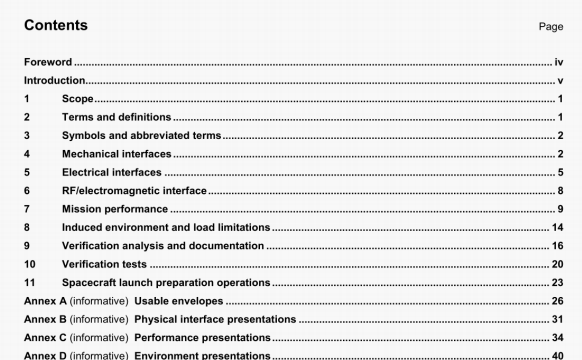ISO 14303 pdf download – Space systems – Launch-vehicle-to-spacecraft interfaces.
5.6 In-flight telemetry
A description shall be made of the type of SC data that can be transmitted to the LV ground stations via LV TM on a standard basis or as options:
dynamic, acoustic and thermal environment at the SC interface;
— specific Internal SC measurements
5.7 Power supply
A general description of electrical circuits associated with the electrical power supply shall be made. Optionally, a schematic drawing of the corresponding electrical circuits may be wicluded, The following main electrical characteristics shall be indicated, together with the tolerances:
— voltage (volts);
current (amperes);
— insulation on the SC side;
— pratection on the Sc side;
EMC.
5.8 Earth potential (ground) continuity
The sc requirements for electrical continuity with respect to the Earth potential (ground) shall be expressed as follows:
location of SC reference point or points:
— maxlmixn resistance between SC metallic elements and the closest reference polnt maximLin resistance of SC interface separation plane.
6 RFielectromagnetlc interface
6.1 General
This clause Identifies the Interface parameters required to define the RF interface and electromagnetic Interfaces between the SC and Lv. SC, LV and LV range RF emissions shall be joritly evaluated to determine compatibility and possible restrictions. For the methodology for venfying these interfaces, see clauses 9 and 10.
6.2 RF telemetry and command link
The LV contractor shall provide TM and command links between the corresponding antennae of the encapsulated SC and the SC system test equipment located in the SPF.
The lmk shall be enabled by RF window, pick-up antenna or other equivalent methods associated with the LV PLF. The link shall be avaiLable from the time of encapsulation of the SC on the LV until launch, except when RF transmission is limited by LV activities. The SC TM and command frequency bands shall not overlap the LV frequencies
For dual- or muftiple-manifest SC launches, a standard daily launch window shall be defined for a period of one year (see annex C, Figure Cl). The SC windows shall include the standard window in order to be compatible with all potential co-passengers.
A reference orbit (including the descending node) and a reference time associated with the standard dual launch window shall be defined. The lift-off time or the time of first perigee passage shal be used as the reference time.
7.3 Elliptical orbits
7.3.1 Performance
The performance capability of the LV for typical elliptical orbits shall be described by means of graphs showing the vanation of the payload mass as a function of the orbital parameters (1%. 11a’
As minimal information, the variation of the payload mass of the LV with apogee and perigee altitudes shall be given for typical values of the orbit inclination (see Figure C.2).
7.3.2 LV Injection accuracies
Envelope values shall be given for the standard deviations (1 r) of the orbital parame(ers
— & (degrees):
— iII, (kdometres);
&I1 (kdometres);
— %o(degrees);
— Ml (degrees).
7.3.3 Launch windows
If the LV or the launch site have launch window constraints, these shall be indicated.
7.4 Sun synchronous orbits (SSOs)
7.4.1 Performance
The perfomiance capability of the LV for SSOs shall be described by means of graphs showing the variation of the
payload mass as a function of orbit altitude, with indication of the corresponding inclriation (see Figure C.3).
7.4.2 LV injection accuracies
As a minimum, envelope values for the standard deviations (la) of the SSO parameters shall be given as follows (optionally, a covariance matrix of the same parameters, or an equivalent set of LV state parameters. may be provided).
ISO 14303 pdf download – Space systems – Launch-vehicle-to-spacecraft interfaces
